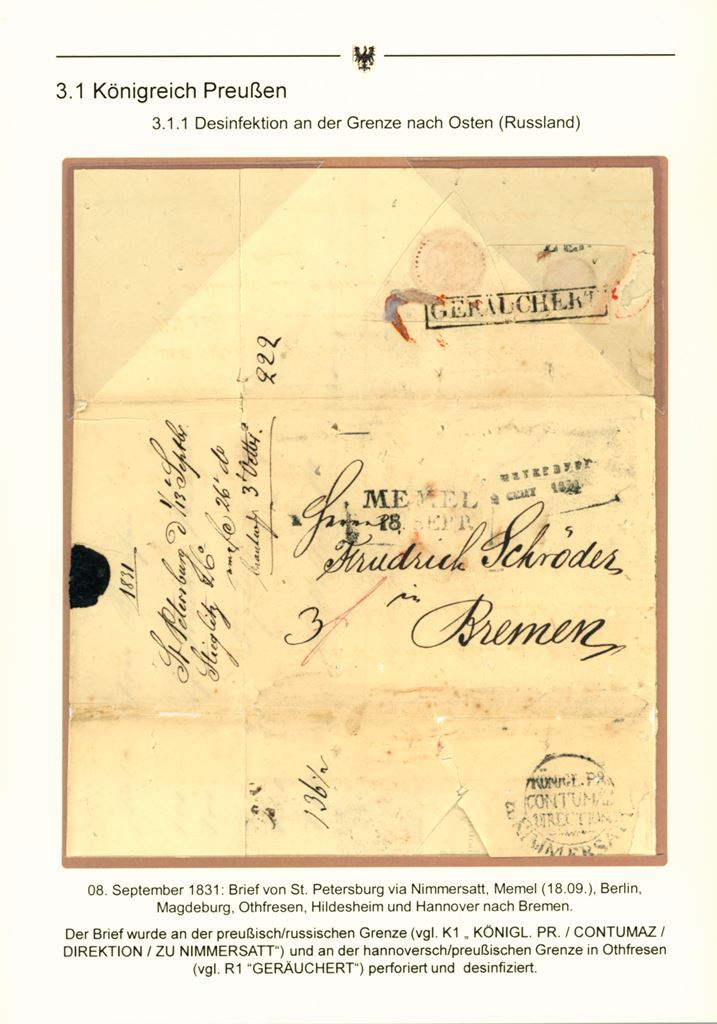Congratulations to all of you three.
Posts by Bjoern
-
-
In the meanwhile the publication commemorating the 140th anniversary of my local philatelistic club in Frankfurt is printed including an articel regarding disinfection in Frankfurt am Main (8 pages):
Festschrift 140 Jahre Briefmarkenkunde in Frankfurt am Main 1878 - 2018 (hardcover - 237 pages - all articles are in German)
- Michael Krug: Vereinsgeschichte der letzten 15 Jahre
- Prof. Fueß: Frankfur und seine Stadtteile im 19. Jahrhundert
- Björn Rosenau: Briefe in den Zeiten der Cholera - Desinfektion von Postsendungen 1831/1832 in Frankfurt am Main
- Heinrich Mimberg: Zum Druck der "Basler Taube" - auf Spurensuche in Frankfurt am Main
- Heinrich Mimberg: Mit der "Postea Europea" nach Kairo - auf Forschungsreise in Afrika
- Erwin W. Friese: Preußen, die zweizeiligen Rechteckstempel ohne Jahreszahl mit Schlusspunkt, sogenannte Liegnitzer Sonderform
- Arnim Knapp: Eine Zeitreise mit den bekanntesten Einheiten des "Sachsen-Dreier", darunter der einzig erhaltene Bogen, der Neuentdeckung eines Vierer-Blocks und vier Briefen, die eine postgeschichtliche Weltrarität darstellen. Das "Malheur von Oschatz" darf auch nicht fehlen
- Carsten Meckbach: Die ersten Ganzsachenkarten der Deutschen Reichspost (Michel P1-P4 und PP2-PP3)
- Uwe Lawin: Dänisch-Westindien
- Michael Peter: Die Ganzsachen El Salvadors von 1883 - 1889
- Louise Nilles: Villeroy & Boch: Ein Unternehmen unter der Lupe
- Karl Louis und Dieter Michelson: Quo Vadis Philatelie? - Rückblich und Ausblick zur Geschichte des Sammelns von Briefmarken
Selling price is 20 € plus shipping costs - if you are interested please send an email to info@phila-bibliothek.de
-
The Cholera epidemic of 1831/32
At this time different post offices operated in Hamburg. The Swedish and Norwegian post office is one of them. Letters that were disinfected there had been pierced by a rastel.
The rastel leaves behind a specific pattern of holes:
– three rows, each with 3 / 4 / 3 holes
– the distance between the outer holes is 72 mm in the first and third row
– the distance between the outer holes is 100 mm in the second row
GotaFrimarken_2018_Los185_rs.jpg
Letter from Stettin December 30th 1831 via Hamburg January 3rd 1832 to the Quarantain Commission in Stockholm, Sweden. The letter was disinfected by the Swedish and Norwegian post office (refer to characteristic pattern of holes).
-
At the moment a publication commemorating the 140th anniversary of my local philatelistic club in Frankfurt is planned and I a have agreed on to write an articel about disinfection in Frankfurt am Main.
To do this I have updated my registry of known letters (please refer to the attachment). Can somebody add something to this list?
Any remarks would be appriciated.
-
I found some more letters in my register (unfortunately rather poor bw copies):
- 1.8.1831: Warsaw via Berlin and Forbach to Paris (refer also to Meyer: page 164/165)
- 1.9.1831: Namslau to Ratibor
- 21.9.183: Krotoschin to Kelbra (refer also to DASV No. 423 page 240f: Prof. Schmidt "Ein Brief aus dem preußischen 'Cordon sanitaire'...")
- 14.10.1831: Lauenburg to Stargard (similar to letter No. 2 above)
-
Hi André,
this is a good idea to collect all these data. Here is a first addendum:
SAN.S:
Berlin 15.9.
Cosel 21.10.
SAN.ST:
Gnesen 6.10.
Landsberg 4.10.
Mrotzen 10.9.
Pillau 14.9.
Schwedt 9.10.
Schwetz 10.10. - 23.10.
Stettin 7.9SAN ST (special form with S upside down - picture to follow):
Graudenz 5.9.
MEWE 14.10.
-
sorry - the attachment was missing in my last statement - now the attachment is available (see above)
-
Dear Hedy,
you can find a similar letter also from St. Petersburg (September 8th) to Bremen (passing Memel at September 18th) here:
The route of your and mine letter was to my opinion: St. Petersburg - Nimmersatt - Memel - Berlin - Magdeburg - Othfresen - Hildesheim - Hanover - Bremen
Disinfection took place in Nimmersatt and Othfresen (Kingdom of Hanover).
The GERAUCHERT-Cache of Othfresen can be classified as followed:
- Dimension: 52 X 8 mm
- Dot after "T" (just a little bit higher than the rest of the letters)
- Broken Frame for the dots over "A"
- Letter are shifted to the top
This type can be associated with Othfresen, proved by the following attached letter (there is an handwritten mark just below the cachet "und das Pq. äußerlich gereinigt Othfresen“ (lit. "and the Parcel disinfected from the outside Othfresen").
-
Dear Hedy,
The boxed cachets "GERAUCHERT" from Hanover all differ slightly:
- in dimension
- some have a dot after the "T" some not
- sometimes the frame is broken by the dots over "A", sometimes not
- The Letters are shifted to the top (or centered)
In your case the type can be classified as followed:
- Dimension: 52,5 X 8 mm
- No Dot after "T"
- Broken Frame for the dots over "A"
- Letter are shifted to the top
This type can be associated with Gartow, which is the rastel station where disinfection took place. In my register I have 5 letters with this cachet date within the following period: 24.09.1831 - 7.1.1832
I have attached another letter (Potsdam via Gartow and Lüneburg to Eckendorf - 24.9.1831) with the same cachet and a handwritten mark "Gartow" (at the top in the center), which is the proof that this type was used at this place (in addtion there is a list dated from 24.10.1831 from the General-Post-Directorium in Hanover regarding all rastels planned or in place on which Gartow as an active rastel station is stated as well).
-
Dear Andre,
all my letters from September and October 1831 from Posen (to Bromberg) with the cachet "SANITAETS / STEMPEL" have this special pattern of the holes.
In my case I measured 17 mm on the long edge.
-
USA 1971, APOLLO 14, Moon Landing Letter No. 54 of 55, illustrated cover, this piece was physically present on the moon, incl. complete signature of lunar module pilot Edgar Mitchell.
Showing the following cachet: DELAYED IN QUARANTINE AT / LUNAR RECEIVING LABORATORY / M.S.C. - HOUSTON, TEXASUS_Apollo-14_Quarantine.JPG
Source: 158. Felzmann-Auction (Germany) - Lot 6238 - Realized Price: 24.000 EUR
-
I have two letters (14.9. and 8.10) from Inowraclaw to Bromberg in my collection, which are both have a "SANITAETS / STEMPEL" on the back. Both cachet are lookin similar to the one which is in the collection of Denis Vandervelde.
Another example we can find in the auction of Peter Feuser Nr. 78 (2013). Again a letter from Inowraclaw this time to Berlin (refer to picture).
So we have four letters from Inowraclaw (all with the same cachet on the back). So for me it is an open question if this type of "SANITAETS / STEMPEL" belongs to Inowraclaw or Bromberg.
At the same auction of Peter Feuser there was another letter from Bromberg with two cachets similar to the second type mentioned above (also on the front side of the letter). Strange to me, that even on one letter both cachet are slighly different (e.g. in the width).
-
Here is another example of this cachet (latest usage in my record list):
Letter from Hamburg via Frankfurt am Main and Strassbourg to Lyon (arrival 10.02.1832).
Disinfection in
- Hamburg (TT-Post-Office) - refer to pattern of perforation
- Frankfurt am Main (TT-Post-Office) - refer to cachet
- France ???
-
Master Data for this cachet / Stammdaten zu diesem Stempel:
Filebase -> Master Data -> Germany -> Thurn und Taxis (
)If you have comments, new dates, or additional examples please add to this discussion



